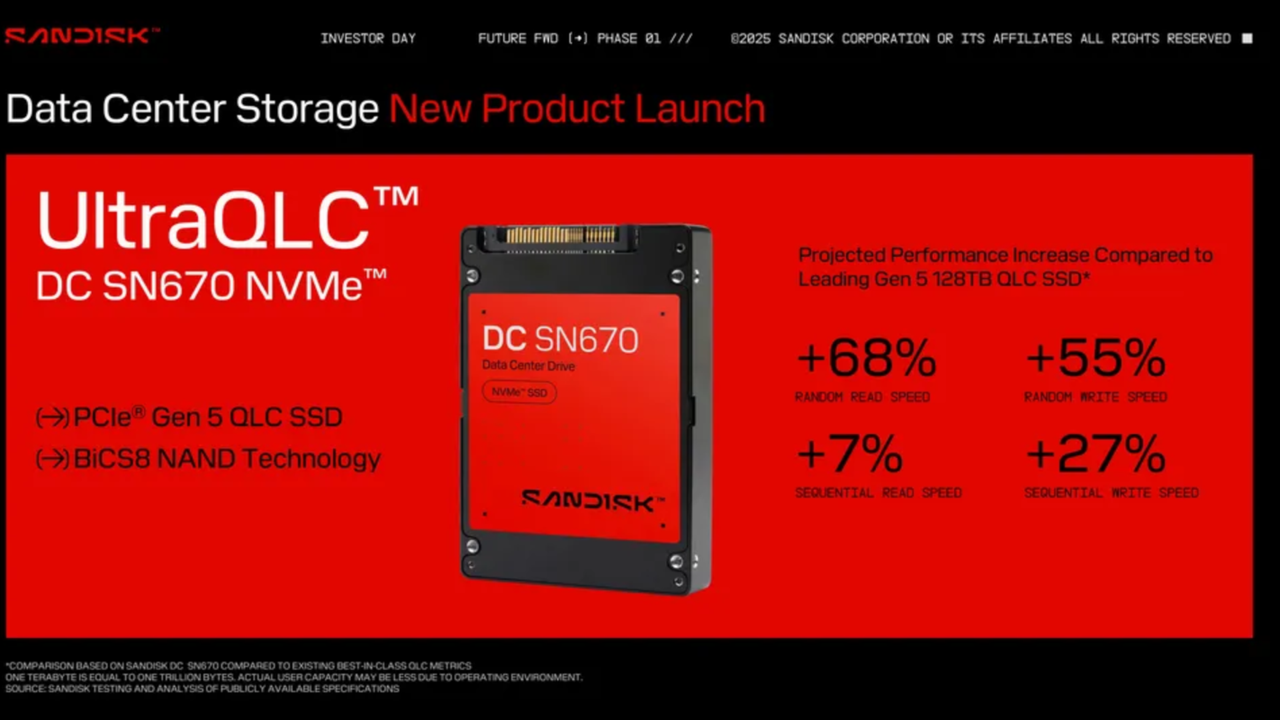- Sandisk’s 256TB SSD skips cache solely, elevating considerations about short-burst workload efficiency
- Claims of sooner speeds stay unverified with out public benchmarks or IOPS efficiency numbers
- Direct Write QLC could sacrifice velocity in change for increased reliability and knowledge integrity
Sandisk has introduced a 256TB SSD, the UltraQLC SN670, which is ready to ship within the first half of 2026.
This mannequin represents the biggest SSD ever revealed by the corporate, marking a daring step towards high-density storage options tailor-made for AI and hyperscale infrastructure.
Though the corporate plans to launch the 128TB model to testers inside weeks, full business availability stays months away.
An structure constructed for scale, not velocity
It connects via a PCIe Gen5 NVMe interface and is a part of Sandisk’s new UltraQLC platform.
In contrast to standard SSDs that buffer knowledge via pseudo-SLC caches, this mannequin makes use of a “Direct Write QLC” strategy.
This simplifies the writing course of and makes the drive extra power-loss protected, nevertheless it additionally introduces tradeoffs, particularly in terms of efficiency beneath heavy or short-burst hundreds.
Signal as much as the TechRadar Professional publication to get all the highest information, opinion, options and steerage what you are promoting must succeed!
With out an SLC cache, the SN670 could endure from slower short-burst writes, inconsistent efficiency beneath load, and elevated controller calls for, making it much less responsive throughout intensive or unpredictable workloads.
Nonetheless, Sandisk claims the SN670 delivers over 68% sooner random reads and 55% sooner random writes in comparison with a number one 128 TB Gen 5 QLC SSD.
The sequential learn speeds are over 7% higher, whereas sequential write speeds enhance by greater than 27% in inside comparisons.
Sandisk has emphasised advantages like Dynamic Frequency Scaling, which is claimed to enhance efficiency by as much as 10 p.c on the identical energy degree
It additionally claims the Knowledge Retention profile may cut back recycling put on by as a lot as 33%.
Each options are supposed to reinforce longevity and cut back vitality consumption.
Nonetheless, none of those claims are backed by disclosed efficiency knowledge equivalent to learn/write speeds or endurance figures.
Internally, the UltraQLC SN670 is supported by a customized controller and firmware, which Sandisk says allows higher latency and bandwidth, however with out precise benchmarks or IOPS comparisons, these statements stay marketing-driven projections.
It’s value noting earlier iterations of Sandisk’s enterprise drives utilizing QLC NAND confirmed limitations in comparison with TLC-based fashions.
On this case, native QLC programming latencies may attain 800–1200 microseconds, a number of occasions slower than SLC-based designs.
Sandisk could also be counting on optimizations like massive DRAM buffers or superior die parallelism, however such architectural particulars have but to be confirmed.
The ultimate product will arrive in U.2 type initially, with extra variants anticipated later in 2026.
For now, Sandisk’s 256TB drive is a symbolic leap towards future knowledge infrastructure, not a sensible possibility for mainstream customers.
Through Blocks and Recordsdata
